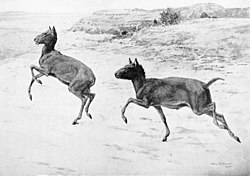| Santa Cruz Formation | |
|---|---|
| Stratigraphic range: Burdigalian-Langhian (Santacrucian-Friasian) ~ | |
 | |
| Type | Geological formation |
| Sub-units | Estancia La Costa Member, Estancia La Angelina Member (coastal section) |
| Underlies | Cerro Boleadoras Formation |
| Overlies | Monte Léon Formation |
| Thickness | Over 295 metres |
| Lithology | |
| Primary | |
| Location | |
| Country | Argentina, Chile |
| Extent | Austral Basin |
| Type section | |
| Named by | Furque & Camacho |
| Location | near Lago Argentino |
| Year defined | 1972 |
 Santa Cruz Province in Argentina, where the majority of the formation of exposed | |
The Santa Cruz Formation is a geological formation in the Magallanes/Austral Basin in southern Patagonia in Argentina and adjacent areas of Chile. It dates to the late Early Miocene epoch, and is contemporaneous with the eponymous Santacrucian age of the SALMA (South American land mammal age) timescale. [1] [2] The Santa Cruz Formation is known for its abundance of vertebrate fossils, including South American native ungulates (astrapotheres, litopterns, notoungulates), [3] as well as rodents, xenarthrans (armadillos, sloths, anteaters), and metatherians.
Contents
- Stratigraphy
- Paleoenvironment
- Paleoflora
- Paleofauna
- Invertebrates
- Amphibians
- Birds
- Squamates
- Mammals
- References
The formation extends from the Andes to the Atlantic coast. In its coastal section it is divided into two members, the lower, fossil rich Estancia La Costa Member, which consists predominately of tuffaceous deposits and fine grained mudrock, and the upper fossil-poor Estancia La Angelina Member, which consists of sedimentary rock, primarily mudrock, and sandstone. The environment of deposition was mostly fluvial, with the lowermost part of the Estancia La Costa Member being transitional between fluvial and marine conditions. The environment of the Estancia La Costa Member is thought to have been relatively warm and humid, but likely became somewhat cooler and drier towards the end of the sequence. [1]









































